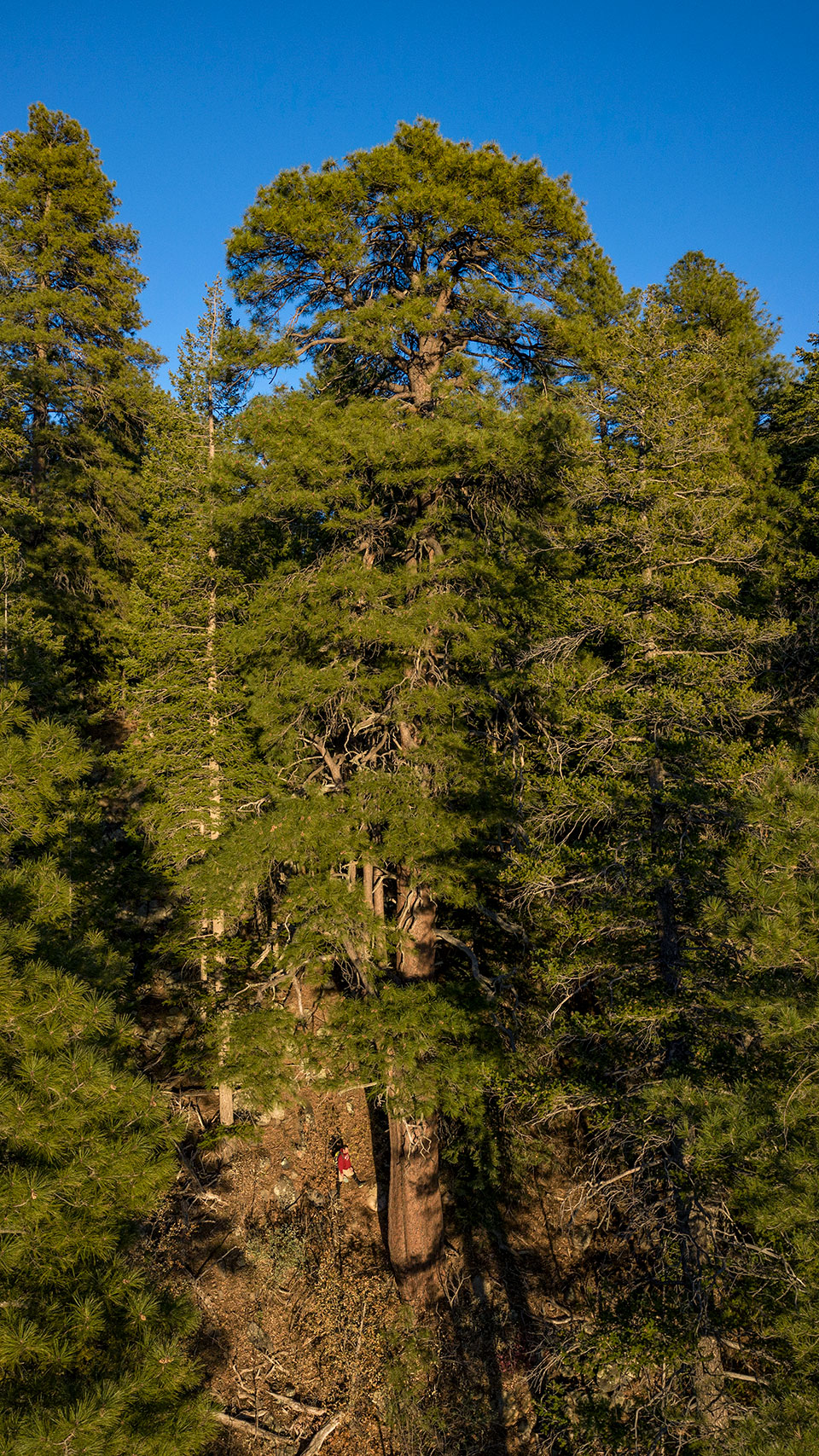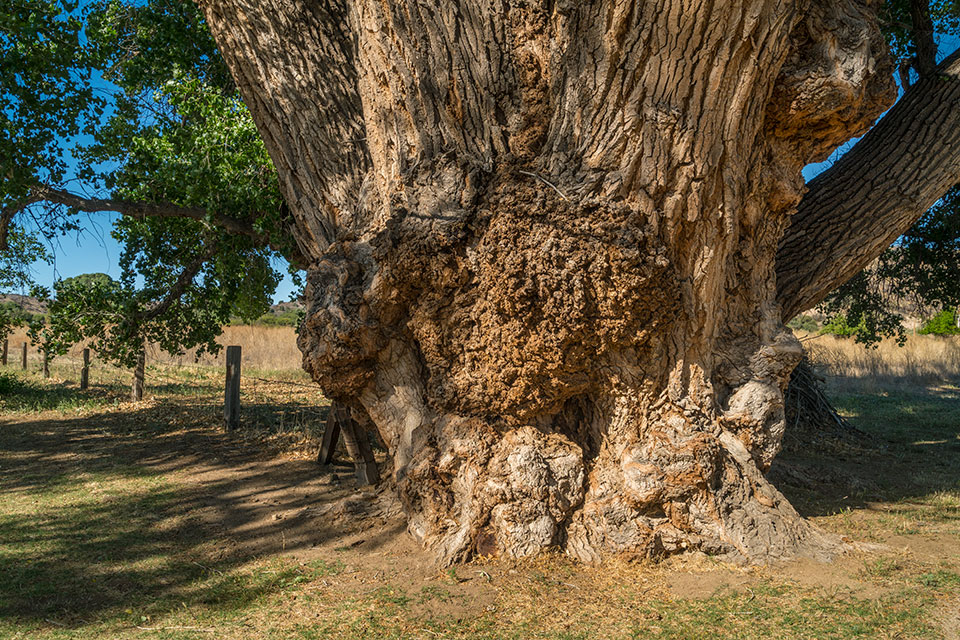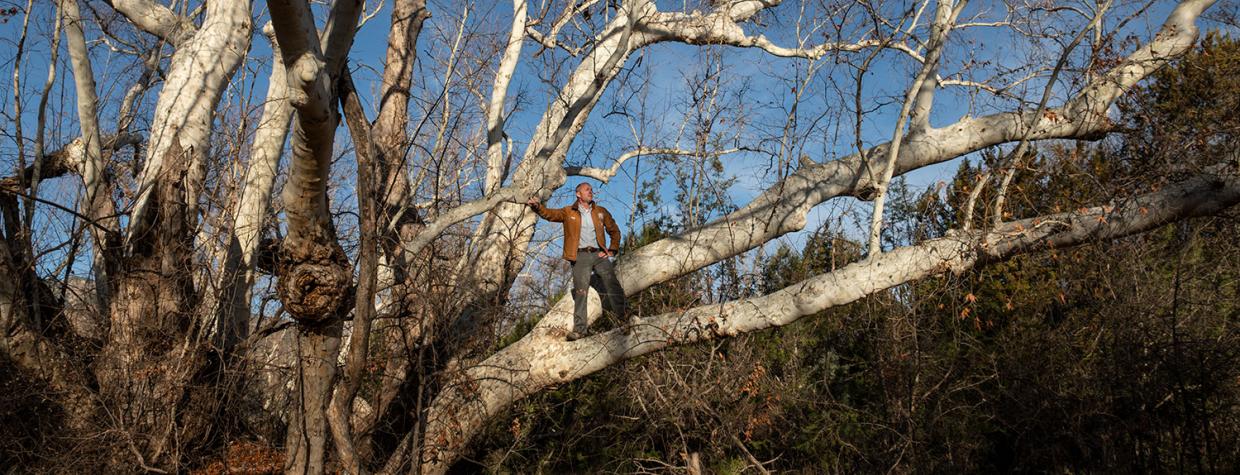Standing just outside Saguaro National Park East, Nick Shipley and I take in the pale, jigsaw-puzzle trunks of sycamores towering all around us. Their graceful arms reach for the winter sky, clutching what’s left of copper-colored leaves like so many tiny handkerchiefs.
We’re on the hunt for a new champion, meaning the largest of its species. And with a life span of up to 400 years, Arizona sycamores can grow very large. Fifty-four feet tall and more than 35 feet around, the current champion is the state’s second-largest tree that we know of — the largest documented tree is a 102-foot-tall Frémont cottonwood with a trunk more than 46 feet around. Both trees are also the largest of their species in the country. Like cottonwoods, sycamores need a lot of water, and the floodplain in which we’re standing provides the perfect conditions for them to thrive.
In his mid-40s, with close-cropped hair and the lean profile of a runner, Shipley is a volunteer with Arizona’s Magnificent Trees and a big-tree
hunter. Standing next to a perfect circle of trunks, he looks tiny.
“Is this one tree?” I ask.
“This is where it gets tricky,” he says, considering. In a floodplain like this, soil and sediment can bury young trunks, causing trees to sprout new suckers. Shipley thinks that happened here and that these trunks are part of the same tree. But someone could question that, and Shipley wants to find an indisputable champion.
“Let’s keep looking,” he says.
Administered by the state Department of Forestry and Fire Management, Arizona’s Magnificent Trees includes three categories: champions; witness trees, which have been in place since Arizona became a state in 1912; and heritage trees, which have cultural significance.
As part of Arizona’s Centennial, the first witness tree was dedicated in 2011; it was an olive tree Scottsdale founder Winfield Scott planted in 1896 as part of a windbreak for a citrus grove in what now is Old Town. The list also includes a cedar planted by Boy Scouts on Prescott’s Courthouse Square on February 14, 1912, to commemorate Arizona’s admission to the union.

Heritage trees can be any size or age, as long as they have a compelling story. For example, an American elm (which also is a witness tree) on the Northern Arizona University campus was grown from cuttings taken from the elm George Washington stood under when he took command of the Continental Army. More recent nominations include a fig tree at Presidio San Agustín del Tucson Museum that Shipley and a former colleague, Jackie Lyle, nominated. That 100-year-old tree likely was cloned from a tree brought from Spain by Jesuit missionaries in the late 1600s.
But the oldest and most popular category is the champion tree program, which began as a chapter of what now is called the National Register of Champion Trees. The nonprofit American Forests registers the country’s largest known species, defined by a point system. Trees earn points for trunk circumference, height and crown spread.
Arizona’s program recognizes the largest trees of their species in the state as state champions. And, unlike American Forests, it doesn’t limit eligible species. For purposes of the program, a tree is any plant that grows taller than surface-level vegetation, with tall woody stems anchored by root systems, and branches that support leaves. “Leaves” includes cactus spines. Thus, state champs include a 9-foot-tall jumping cholla, a 14-foot-tall prickly pear cactus and a 34-foot-tall catclaw.
Champion trees need to be remeasured every 10 years, and program coordinator LoriAnne Barnett Warren trains volunteers to remeasure existing champions and verify new nominations. But anyone can nominate a tree.
“The big, broad goal for the Arizona’s Magnificent Trees program is to get people interested in and appreciating trees,” Warren says. “We are using this program to engage people broadly in the importance and value of trees to our neighborhoods and ecosystems, as well as to appreciate the majesty of trees … [in] both the built environment and the forests and ecosystems.”
Scientists are still discovering just how remarkable trees are. They play an important role in sustaining biodiversity, particularly in desert riparian zones. The bright green leaves of cottonwood trees signal the presence of water like a beacon, not only for people but also for birds and wildlife. Trees provide both shelter and sustenance and can dramatically mitigate warming effects. “Not only do they shade us from the sun and the solar radiation, but they actually transpire,” Shipley says. “A lot of people don’t know that. That’s why it’s so much cooler under a tree,” which acts like an evaporative cooler.
In 2014, Arizona State University researchers found that adding a 25 percent tree canopy to
a neighborhood with no vegetation could lower the temperature by nearly 8 degrees. More recently, scientists learned that trees communicate with each other using an underground network of fungi that operates like a neural network. In one study, a Douglas-fir injured by insects appeared to send warning signals to a nearby ponderosa pine, which then produced enzymes to protect itself. And even humans benefit from these defense mechanisms. The chemotherapy drug Taxol, for instance, is derived from a substance that yew trees produce for their own defense.
What’s more, “mother trees” care for their offspring by sharing carbon and nutrients at crucial times in their seedlings’ growth. Then, as they get old and decline, they transmit nearly half of their carbon to neighboring trees, helping to regenerate the forest.
Trees can also anchor us in time and place: If you see a Joshua tree or a saguaro cactus, you can’t be anywhere but the Southwest. And they can connect us to the past: A tree planted by a grandparent represents a person in history, muses Jan Emming, who’s growing a desert botanical garden on 40 acres near the small Mohave County community of Yucca.
That sense of history extends to trees in the wild. Bristlecone pines exist in isolated groves at high altitudes in California and Nevada where little else grows. The oldest has survived for nearly 5,000 years, and scientists believe these trees are the oldest living individual organisms known to man. “That tree germinated when the Egyptians were building the pyramids,” Emming says. “You get a deeper sense of time if you ponder it.”
And, of course, there’s the beauty of a forested land resplendent in fall color, Emming says. “Most people have an inherent connection to trees,” he adds. “It’s built into us by our very nature.”
In September 1940, the American Forestry Association, now called American Forests, launched a campaign to find the largest living specimens of American trees. The goal was to engage the public in forestry activities, and what originally was called the National Register of Big Trees grew out of that hunt.
In 1991, ASU Arboretum horticulturist Richard Harris organized the Arizona Register of Big Trees. The state already had a few champions by that time; the first was a velvet mesquite in Southern Arizona, nominated in 1949 by Gilbert Sykes, a Coronado National Forest ranger. (That tree still holds the title.)
But most were nominated by people passing through the state. A big-tree hunter from Oregon, famous for driving around the country and nominating trees in species with no champions, nominated six, most of them along major highways, on a trip through Arizona in 1977.
Retired forestry professor Bob Zahner knew there had to be more, and better, trees in Arizona’s mountains, canyons and deserts. When he offered to serve as the state’s Register of Big Trees coordinator in 1993, the national register listed 16 champion trees in Arizona. By 2005, shortly before Zahner resigned, Arizona claimed 88. As of 2021, the count stands at 47.
Zahner’s co-coordinator and successor, Ken Morrow, had independently stumbled on the national register and was carrying a handwritten list of species, dimensions and point totals in his wallet when he read a story about Zahner in 1994. “I got a hold of Bob and said, ‘How can I help out?’ ” Morrow recalls. For his first assignment, Zahner sent him out to remeasure an elephant tree.
“GPS was just becoming a thing,” Morrow recalls. “So, people would have these descriptions — ‘Take Highway 70 to Forest Road 163 and go north’ — and you would just sort of wander around and find the biggest one and match it to a photo. In many cases, there weren’t even photos.” He never did locate the champion. But he did nominate a bigger tree.
Zahner was behind the requirement to remeasure champions every 10 years, Morrow says. He also helped set standards for measuring non-standard trees. American Forests’ standard of measuring a tree’s circumference 4.5 feet from the ground worked well for towering, single-trunk trees, but the Southwest has many smaller species, as well as some with multiple trunks. How to measure them?
“He would always be sending some missive or another to the national coordinator,” Morrow recalls. “You’d just get to know this person, then that person would be gone and someone else would fill those shoes, and Bob would have to take up where he left off.”
But Zahner also spent plenty of time hunting new champions. In a 2006 article for American Forests just after his health forced him to resign, Zahner wrote about his most exciting nomination, a type of rosewood found in a remote canyon at Organ Pipe Cactus National Monument.

But champion trees are not always in remote locations. Shipley, for example, nominated a desert hackberry he planted years ago in his own neighborhood, as well as a foothill paloverde at his business, Civano Nursery. The paloverde was already in place before the nursery was built and benefited from the extra water. That also was true for a recently nominated national champion, a one-seed juniper at Sky Ranch Lodge in Sedona.
The lodge also nominated four state champs that owner Gary Graham had planted as part of the resort’s botanical garden. In fact, botanical gardens and arboretums are great places to find champions. Tohono Chul, in Tucson, has four state champs. Boyce Thompson Arboretum, near Superior, has three state and two national champions. The arboretum on the University of Arizona campus boasts three state champs and one national champ. And the champion Frémont cottonwood? It’s on an irrigated lot and is one of four trees planted to mark the property’s boundaries.
With successes come failures. “A big-tree coordinator’s job is a roller coaster of expectations and disappointments,” Zahner wrote. Champion trees often reach the end of their natural life spans or die from natural causes. They also fall prey to drought, disease and disasters, both natural and man-made: A champion date palm at Tohono Chul fell over in a storm, while a champion cholla was destroyed by a road grader.
“Arizona is a state with frequent severe wildfires, which keeps us on the alert monitoring our many champions,” Zahner wrote. “We have lost to wildfire an average of one a year. … In the desert, lightning strikes are tree killers, and our giant saguaro cacti are the tallest things out there. Three times over the past 10 years it has been devastating to find our champion saguaro splattered on the ground.”
In 2012, the Department of Forestry and Fire Management took over stewardship of the register from Morrow, combining it with the Arizona Community Tree Council’s Great Trees program, which included witness and heritage trees, and putting them all under the umbrella of Magnificent Trees.
Within an hour, Shipley and I find our first indisputable contender. Because it’s measured in inches, tree circumference counts the most, so we’ve measured the circumference of every promising sycamore, moving on when it wasn’t close to the current champ’s 424 inches.
“Let’s measure this guy,” Shipley says. I hold one end of the tape while Shipley circles around.
“Look at that,” he says. “Thirty-three nine.” Punching numbers into his cellphone, he calculates 405 inches. At 80 feet, though, our tree is significantly taller. Being an arborist, Shipley uses a device called a clinometer to measure the height, but there’s an easy way to estimate height without one — namely, taking a picture of an object of known height, such as a person, next to the tree.
After taking an average of two crown-width measurements, Shipley calculates a score of 515.5 — 11 points higher than the current champ. “It’s a good-looking tree,” Shipley says appreciatively. “That’s my thing. A lot of times, these champion trees, they’re at the end of their life cycle. So sometimes, they’re not very attractive. I want it to be a big specimen, but I also want it to be a nice specimen.”
We keep looking, agreeing to come back to this tree if we don’t find something bigger.
Like most big-tree hunters, Shipley is an avid hiker. His father owned a nursery in Canada, and when Shipley moved to Tucson, he and his brothers started Civano Nursery; the family now also runs Civano Growers, a wholesale growing farm. Among the nursery’s early operations was salvage: When developments and golf courses were planned, the company would go out ahead of the bulldozers, saving viable plants and trees. For years, Shipley walked the desert conducting plant surveys, measuring trees and counting cactuses.
“That’s how I got into trees,” he says. About 20 years ago, he became certified as an arborist. Jackie Lyle, who worked at Civano Growers, told him about the Magnificent Trees program. “I think she showed me a paloverde that was the national or state champion, and I said, ‘Oh, I’ve seen bigger,’ ” Shipley recalls. “And that’s what got me inspired.”
We hike for hours, first splashing up and down Turkey Creek and then walking along a gravel road that parallels it. We’re about to turn around when the road rises and the sycamores give way to shrubby mesquites. Then, Shipley spots an unusually tall, broad set of limbs in the distance and sets off like a dog on a hunt. Lumbering through chest-high grasses that leave us covered with burs, we reach the tree, which clings to the bank of a dry creek.
“Let’s take a visual of this,” Shipley says with the excitement of a child. “Boom. Champion tree.”
The tree is enormous, its gnarled trunk knotted like a clenched fist with arthritic knuckles. A tangle of roots lies exposed on the wash side, leaving a gap like a little cave at the base. “Self-pruned” limbs the size of smaller trees litter the ground. We decide to measure only the half of the sycamore that’s indisputably one tree.
“God, it’s big,” Shipley says, circling the trunk with the tape measure. The circumference measures 428 inches, 4 inches more than the current champ. It’s also much taller, at 82 feet, and has an average crown spread of nearly 100 feet. We calculate 534.75 points, which beats the current champ by more than 30. A clear winner.
Shipley records the GPS coordinates, and we take turns photographing each other with our trophy, looking like gnomes at the base of the trunk. Tired but triumphant, we stagger back to the truck to take a last drive along the gravel road, braking when we reach a gate.
“Shall I open it?” I ask.
“No, I’m happy with our tree,” Shipley says. “There’s always bigger.”

